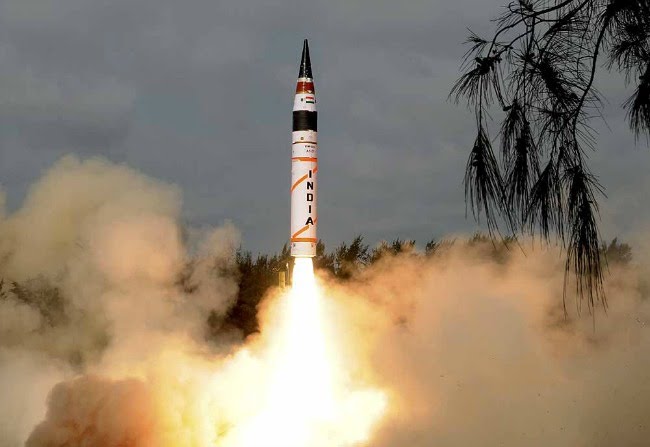
How the Agni 5 missile testing fires up India’s defence capabilities
The high-precision missile with 5,000-km ranges leaves India better prepared for a potential Chinese offensive

In what is viewed as a strong message to China, India on Wednesday successfully test-fired the Agni 5, a surface-to-surface ballistic missile capable of striking targets, with precision, from a distance of 5,000 km. The missile had, in fact, been inducted about three years ago, but it’s only now that the elite Strategic Forces Command (SFC) has tested it.
The Agni 5, categorised as an Intercontinental Ballistic Missile (ICBM), took off from the APJ Abdul Kalam Island, off the Odisha coast. Why is the missile of critical importance to India, and what does it mean to relations with China?
What Agni 5 offers
India’s latest missile can accurately strike targets 5,000 km away. This means almost all of China is within its target range. It is considered India’s closest contender for an ICBM, since its range could also help it reach countries across continents such as Africa and Europe.
Also, while the Centre has stated that Agni 5’s range is 5,000 km, media reports suggest that it can even reach targets 8,000 km away. Additionally, it has a launch weight of 50,000 kg, and can carry a warhead of about 1,500 kg. What also makes it a potent missile is that it uses a three-stage solid fuelled engine and can hit targets with great precision.
Also watch: Army holds drills in Arunachal amidst LAC standoff
Agni missiles, from 1 to 5, are designed and developed by the Defence Research and Development Organisation (DRDO). While Agni 1 offers a 700 km range, versions 2, 3 and 4 offer 2,000 km, 2,500 km and 3,500 km, respectively.
The latest version of Agni is a canisterised missile, in that it can be launched from road and rail platforms. This renders launch and deployment easier and quicker. Plus, the missile enjoys a longer shelf life and can operate in harsher climatic conditions.
The Chinese offensive
Wednesday’s testing of Agni 5 is seen as New Delhi’s response to Beijing for a few of reasons. First, India-China relations are at a fresh low amid frequent border skirmishes. An escalation of threats may require India to retaliate.
Second, China is said to have tested a new hypersonic missile in August. It was reported to be a nuclear capable missile that circled the earth before moving towards its target (which it missed by around 25 miles). China flat out denied the development, calling it a spacecraft and not a missile. But media reports said the country had demonstrated its capability in hypersonic glide vehicle technology. The move raised hackles not just in India, but also in the US, which has also seen its relations with China sour in recent years.
The Agni 5 test’s success “is in line with India’s stated policy to have ‘credible minimum deterrence’ that underpins the commitment to ‘No First Use’”, said the Centre. This means while India won’t launch an offensive against China, it is fully geared to defend itself.
Bipin Rawat, Chief of Defence Staff General, was quoted as saying last month that India is looking at a rocket force for missiles. It is not clear how much shape that proposal has taken.
How do the other nations fare?
China aside, the US and Russia are said to be developing ICBM technology. A Rand Corporation report named France and India as the ‘most committed’ nations in terms of gaining the capability. “Both draw to some extent on cooperation with Russia,” it added. Australia, Japan and European entities are engaged in ICBM research, said media reports citing the Rand study.

